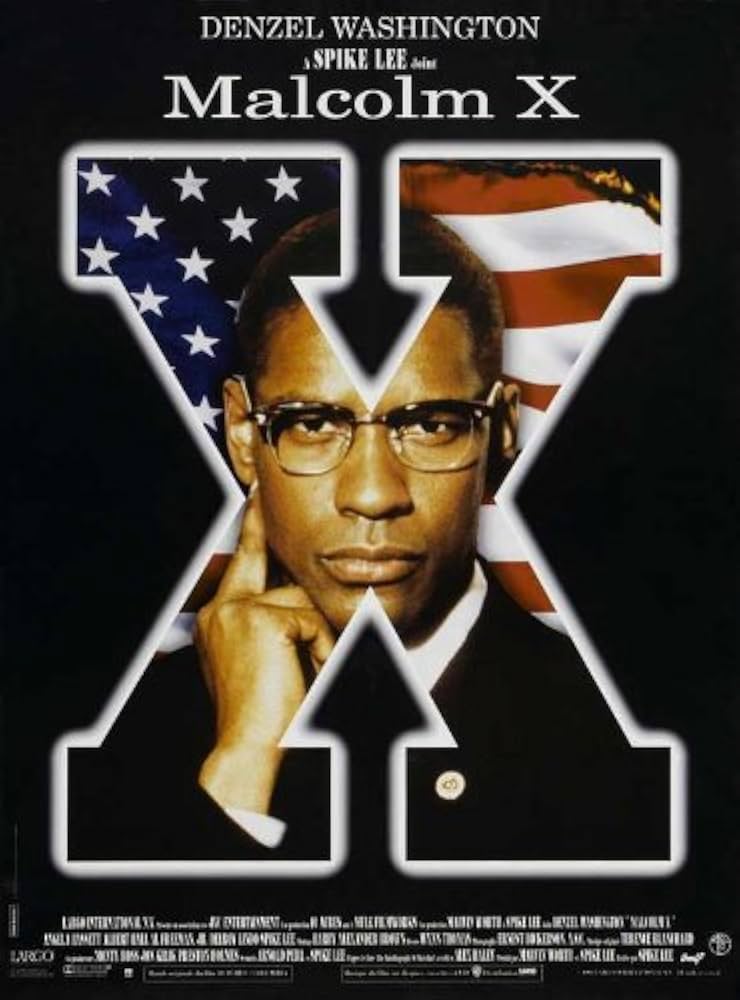
Malcolm X
Spike Lee’s “Malcolm X” isn’t just a movie – it’s a movement captured on film, a three-hour-plus journey through one of the most complex and transformative figures in American history. And let me tell you, if you think you know Malcolm X’s story from your history books, this film will make you think again.
The film follows Malcolm Little’s evolution from a small-time hustler (played with explosive charisma by Denzel Washington in what should have won him the Oscar) to the powerful, controversial, and ultimately transformative figure known as Malcolm X. It’s a journey that takes us from the streets of Boston and Harlem to the holy cities of the Middle East, and from militant black nationalism to a more universal, though no less revolutionary, vision of human rights.
Lee structures the film like a religious conversion narrative – which, in many ways, it is. We begin with Malcolm as a “red” conk-wearing hustler, running numbers and pulling scams with his buddy Shorty (played by Spike Lee himself). This section plays almost like a gangster film, with its zoot suits, lindy hop dancing, and jazz soundtrack. But beneath the flash, we see the systematic racism that shaped Malcolm’s early worldview.
The prison sequence marks the first transformation, as Malcolm encounters the teachings of the Nation of Islam through fellow inmate Brother Baines. Washington brilliantly portrays Malcolm’s awakening, showing us a man literally remaking himself through education and religious conviction. His famous scene practicing writing on prison paper – starting with “A” and filling every inch of space – is a masterclass in showing intellectual awakening on screen.
As Malcolm X, the Nation of Islam minister, Washington captures both the fire and intelligence that made Malcolm such a magnetic speaker. The film doesn’t shy away from his more controversial statements but contextualizes them within the reality of 1960s America. When Malcolm speaks, whether to small groups or massive crowds, you understand why people listened.
The final act deals with Malcolm’s break from the Nation of Islam, his pilgrimage to Mecca, and his evolution toward a more inclusive worldview – while never abandoning his commitment to black empowerment and human rights. It’s here that the film reaches its tragic but transcendent conclusion, with Lee skillfully weaving documentary footage into the narrative.
What Soars:
- Denzel Washington’s performance is a tour de force that captures Malcolm’s intelligence, charisma, and evolution
- Ernest Dickerson’s cinematography shifts with each phase of Malcolm’s life, from the vibrant colors of his hustler days to the stark clarity of his later years
- The supporting cast, particularly Angela Bassett as Betty Shabazz, brings depth to every scene
- Spike Lee’s direction balances intimate personal moments with sweeping historical drama
- The use of actual footage and photographs grounds the film in historical reality
What Struggles:
- At 3 hours and 22 minutes, the film demands significant viewer commitment
- Some of the early period sequences can feel slightly stylized
- The complexity of Malcolm’s political and religious ideas sometimes gets simplified
- The film’s structure occasionally makes it feel like multiple movies in one
The Verdict:
“Malcolm X” is more than a biopic – it’s an American epic that forces us to confront our nation’s painful history while celebrating the possibility of personal transformation. It’s a film that understands its subject was not just a historical figure but a living, breathing, evolving human being who contained multitudes.
Lee and Washington don’t give us a sanitized hero or a simple villain, but rather a man who constantly questioned, grew, and fought for what he believed was right, even as those beliefs changed. It’s a film that reminds us that the past isn’t past, that the questions Malcolm X grappled with – about justice, identity, resistance, and human dignity – remain urgently relevant.
Rating: 5 out of 5 raised fists
P.S. Pay attention to the film’s opening credits sequence, which intercuts the American flag with footage of the Rodney King beating – a reminder that Malcolm’s story isn’t just history, but a continuing conversation about race and justice in America. Also, the fact that Spike Lee had to reach out to prominent African American artists and athletes to help fund the film’s completion adds another layer to its significance as a piece of cultural history.